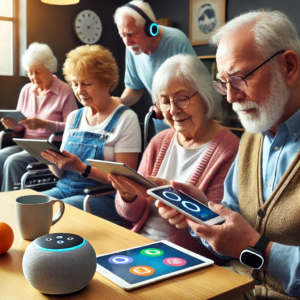Toros E, Asiksoy G, Sürücü L. Refreshment students’ perceived usefulness and attitudes towards using technology: a moderated mediation model. Humanities and Social Sciences Communications. 2024;11(1):1-10.

The findings reveal that older learners who perceive technology as beneficial in their daily lives are more likely to adopt and develop positive attitudes toward its use. The simplicity and user-friendliness of technology further enhance this effect, acting as a bridge between its perceived usefulness and attitudes. Moreover, the confidence of older adults in their ability to use technology, defined as gerontechnology self-efficacy, strengthens their willingness to engage with it. Individuals with higher levels of self-efficacy demonstrate a more open and accepting approach to technology.
This study highlights the importance of designing interventions tailored for older adults, emphasizing the utility of technology, simplifying its usage, and building user confidence. Such efforts are essential for fostering active aging, supporting independence, and enhancing the quality of life through greater technological engagement.

Dr. Gülsüm Aşıksoy is an associate professor at the Department of Education and Instructional Technology, Near East University. For those interested in researching gerontechnology and technology adoption among older adults, Dr. Gülsüm Aşıksoy ([email protected]) is available for inquiries and collaboration. With expertise in educational technologies, Dr. Aşıksoy provides meaningful insights and support for advancing work in this field.
Abstract
This study aims to understand the attitudes of Refreshment students who are active learners towards the use of technology. A model was developed by utilising four important factors impacting technology usage attitudes, namely perceived usefulness (PU), perceived ease of use (PEOU), gerontechnology self-efficacy (GTSE) and attitude towards using technology (ATUT). Quantitative research was used to test the study model. A survey was administered to 318 participants selected through convenience sampling to collect data, which were analysed using AMOS 21.0 and SPSS 26.0 software programmes. The results confirmed that PU influences the attitudes of Refreshment students towards technology usage and PEOU mediates the effect of usefulness on their attitude perception. Moreover, GTSE was found to have a moderate mediating role in the effect of PU on Refreshment students’ attitude through PEOU. The results of this study hold significant implications for the design and implementation of gerontechnology. Theoretically, the findings align with the Technology Acceptance Model (TAM), suggesting that older adults are more inclined to adopt technology if they perceive it as useful and user-friendly. In practical terms, the study indicates that interventions aimed at enhancing the utility, ease of use, and accessibility of gerontechnology for older adults are likely to be effective in increasing their technology adoption. Overall, these findings underscore the importance of making gerontechnology more accessible and user-friendly, potentially enhancing older adults’ technology adoption and thereby improving their overall quality of life.
